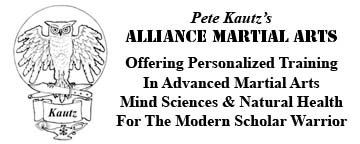|
|
Enter your e-mail address below & watch for a free weekly Training Tip on some aspect of martial arts, blade craft, conditioning, self defense, health, physical culture, history, mind training, attribute development & more |
What's New - Timeline - Articles - Techniques - Catalog - Seminars - Links - Contact Us
|
|
|
|
Comtech Trapping III: Iron
& Rattan Ring |
|
|
Hoop & Ball Solo
Sensitivity Training
Copyright Pete Kautz 2018
Sensitivity training or the ability to sense and respond to pressure without conscious thought, is a core skill in both Wing Chun and Kali, as well as many other world arts. This is an important attribute because it is faster than anything requiring you to consciously see and respond to stimuli. Developing sensitivity with a partner is done through such drills as chi sao (sticking hands) and hubud lubud (to tie and untie). But, how do you develop sensitivity and strength when training solo? That's the point of this video which you can see on the Alliance site! Here you'll see how the hoop and the ball are complimentary training devices which develop the correct structure and lines of power. The hoop allows you to express power in an outward direction and the ball lets you express it in an inward direction.
The outward power lines will aid you with tan sao and bong sao (what I refer to on the video as positions 1 and 2) and the ball develops your inward power lines for the fook sao (position 3). When teaching a brand new student chi sao here's the 1-2-3 formula: 1) Have them perform the solo drill with the ball first because it forces them into the correct structure for the tan sao and bong sao (positions 1 & 2). 2) Have them do the outside double fook sao (position 3) as you do the inside alternating tan / bong rolling so they get to see / feel it in action. 3) Switch roles and have them do the alternating tan / bong while you do the double fook. By this point they'll be up and rolling and it will be easy to introduce them to having one hand inside and one hand outside. At first, we just call the hand position 1, 2 and 3 and we don't worry about the Chinese names. Only after they can make the physical actions to some degree do we get into that. This is because I don't want them fighting a memory contest while they're learning a new skill. Remember, the tan sao, bong sao, and fook sao are considered to be the three most important techniques of Wing Chun when you read the kuen kuit (martial poems). They are collectively called the Three Treasures by some translators and the Three Terrors by others, either way showing their importance. Regardless, I think they are a treasure if you know them and a terror if you have to face them! All my very best to you, Pete Kautz PS - Like this Article? Sign up for the Training Tips at the top of the page and get an original article like this sent to you by e-mail every week on Tuesday!
|
|
Check Back Next Week For A NEW
Special!
What Will It Be???
What's New - Timeline - Articles - Techniques - Catalog - Seminars - Links - Contact Us
